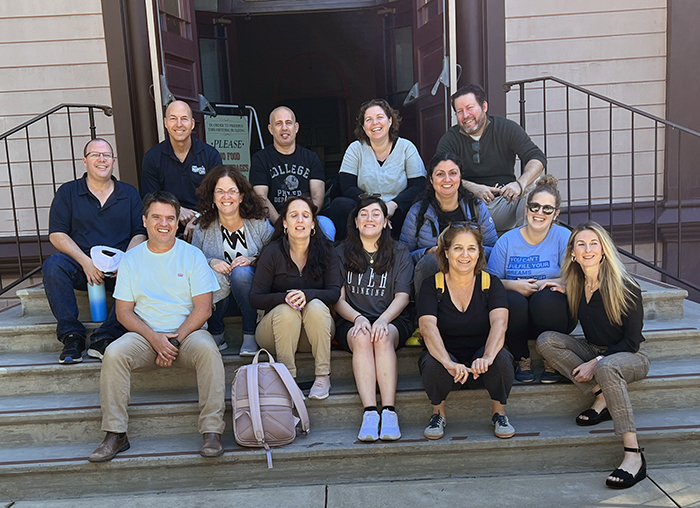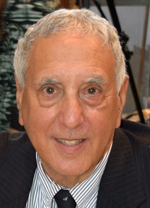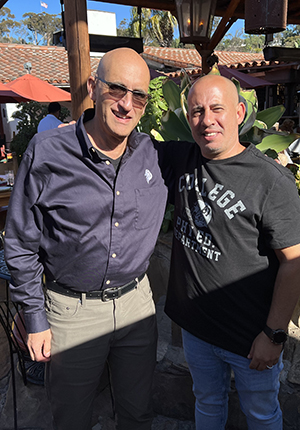
By Donald H. Harrison


SAN DIEGO – There are some things that schools in Sha’ar Hanegev, Israel, and San Diego have in common, and there are somethings that they definitely do not.
Igal Dadiya, superintendent of the 4,121-student school district on the border with Gaza, arrived in San Diego on Tuesday for a six-day visit, principally with Zvi Weiss, head of school at the San Diego Jewish Academy. Nine other Israelis will meet with leaders of San Diego Jewish agencies and organizations serving parallel needs. Among those greeting the Israeli delegation at a lunch at the Fiesta del Reyes at Old Town San Diego State Historic Park were Presidents and CEOs Heidi Gantwerk of the Jewish Federation of San Diego County and Michael Hopkins of Jewish Family Service.
San Diego and Sha’ar Hanegev have a longstanding relationship that originated as part of The Jewish Agency for Israel’s Partnership2Gether (P2G) program, which connects global and Israeli communities in city-to-city and region-to-region partnerships in which participants forge meaningful connections through unique programs and one-on-one encounters. Today, the Federation and Sha’ar Hanegev run the partnership independently.
Special problems faced by the preschool-through-12th-grade school district in Sha’ar Hanegev (Gateway to the Negev) are security for the students in a region often targeted by missiles fired by terrorists in neighboring Gaza, and persuading the students that there are jobs and good futures for them in that rural, agricultural area.
Dadiya, who was a school principal in the Tel Aviv suburb of Holon before accepting the school superintendent position at Sha’ar Hanegev, said that students from 11 kibbutzim and one moshav who are bused to the three-school campus need to learn what to do when sirens indicate missiles are incoming.
“When they are coming to school in the morning, they need to wait in the bus station, because there are bomb shelters nearby,” Dadiya said. If the alarm should be sounded while the bus is en route to the school or returning to their homes, “they need to get off the bus and lie down and listen to what the teacher tells them what to do. They must hear what the teacher tells them.”
At the schools themselves, there are important safety rules to be followed. If the warning sounds while they are on the playground, children must stop what they are doing and run inside the schools, which thanks to contributions from the Jewish Federation of San Diego have been hardened against missile attacks. Some students “don’t have the awareness to go inside the buildings; they keep playing in the yard” and must be shooed inside by their teachers. Sha’ar Hanegev is so close to Gaza, there are no more than 15 seconds between the alarm and when a missile could strike.
In Israel, most Jewish students automatically go into the Israel Defense Forces at age 18, serving at least 2 years if they are women and 32 months if they are men. After they complete their service, many will look for jobs in Israel’s core cities of Jerusalem, Tel Aviv, and Haifa. The school system in Sha’ar Hanegev does what it can to encourage Sha’ar Hanegev residents to return home.
From the time the students are in elementary school, local pride is taught. “We teach them what is special in Sha’ar Hanegev. In high school, they learn some subjects in the kibbutzim, so they will know about our culture, and what is unique about us.”
Among aspects of Sha’ar Hanegev that are stressed to students are the development and use of new technologies for agriculture in the relatively wide-open spaces of their area. Sha’ar Hanegev is known for its dairy industry and for the great variety of vegetables it grows, Dadiya said. “We don’t live in a city, we don’t have a crowd. We live in an open area, wild in places, different from other areas of Israel. They don’t want to live crowded. They want open spaces.”
*
There is a partnership between the San Diego Jewish Academy and the two lower schools and one high school of Sha’ar Hanegev. Zvi Weiss, SDJA’s head of school, stayed at Dadiya’s residence when he visited Sha’ar Hanegev, and Dadiya will be his house guest on this trip. Like Sha’ar Hanegev, SDJA serves students from the very young to those graduating high school
The Sha’ar Hanegev-San Diego Jewish Academy relationship “is important,” Dadiya says. “It is based on trust. We talk about the basic things and then we build upon it.”
Weiss agreed, saying, “We have a very deep respect for each other and for our work. I look forward to him seeing our work here. We have our leaderships building their relationships. We are already seeing some fruits of that. In the middle school, both of us have STEAM [science, technology, engineering, arts, mathematics] programs that work according to a design process. Each of our schools is designing different solutions to issues like water, drought, and environmental concerns. They are sharing their ideas with their peers on the other side of the globe to get feedback from them, so they are serving as peer review committees to each other.”
Approximately 40 SDJA students will visit Sha’ar Hanegev next year as part of a trip that will also take them to Poland and to other parts of Israel. “They will get a chance to connect with students in person who they have been working with this year,” Weiss said during a joint interview with Dadiya. “The dream is that we will have students from Sha’ar Hanegev able to visit us in San Diego, so that it becomes a regular exchange. Beyond that is having teacher exchanges.”
Visits to each other’s schools develop educators who become passionate about building the program, Dadiya said. Sha’ar Hanegev teachers are “inspired by the things that they [SDJA teachers] can do, and his staff comes to Israel and sees what we are doing, so everybody wins.”
For years, children in the 2nd grade had been doing simple things like sending each other Rosh Hashanah cards, but now as the schools are emerging from COVID, ‘we are looking forward to not only recreating what we used to have, but taking it five steps further,” Weiss said.
“Even though the hours are different (Israel is ten hours ahead of San Diego) and the distance is far away, we can bond,” said Dadiya.
The time difference makes class-to-class Zoom calls impossible, but classes can send videos to one another, the two educators said.
Weiss and Dadiya said they plan to talk during the Israeli’s visit here about projects their students can do together in agriculture, music, art and technology.
“It is really about person-to-person connections,” Weiss added. “Kids see him, they hear from teachers, they read history, but knowing people, and especially those living so close to Gaza, where their lives are in our headlines all too often, builds a connection that goes way beyond what they can learn in a text book or a school assembly. They might build a rocket ship together, but at the same time, they are going to make friends over there. To me that is the ultimate goal.”
Most of the students of the Sha’ar Hanegev municipality –though not all – come from secular backgrounds. “I think we have a lot to show them about how we have to go out of our way to build our Jewish identity in the United States, whereas in Israel it is taken for granted,” Weiss said. “In the process, some things may be lost in Israel that we can show them or that they might appreciate here.”
San Diego Jewish Academy can show Sha’ar Hanegev students “what it means to be Jewish beyond just being Israeli. … There is a lot more Jewish tradition at our school that is not as prevalent in Sha’ar Hanegev. Even though many of our students’ lives are secular in many ways, there is still an appreciation for prayer, appreciation for Torah, that they will be able to give [to] Sha’ar Hanegev students.”
Dadiya said the students can learn from each other. He said his students will understand that 7,000 miles from them are people “who share the same religion, values, and traditions.”
Weiss said San Diego students can see that in Israel, where IDF service is part of the nation’s fabric, “there is a sense of patriotism, nationalism and commitment that is very different in nature than what our students experience on a day-to-day basis.”
“We don’t take something material from each other,” Dadiya commented. “We take something that is spiritual. This is the nature of the relationship.”
*
Donald H. Harrison is editor of San Diego Jewish World. He may be contacted via donald.harrison@sdjewishworld.com